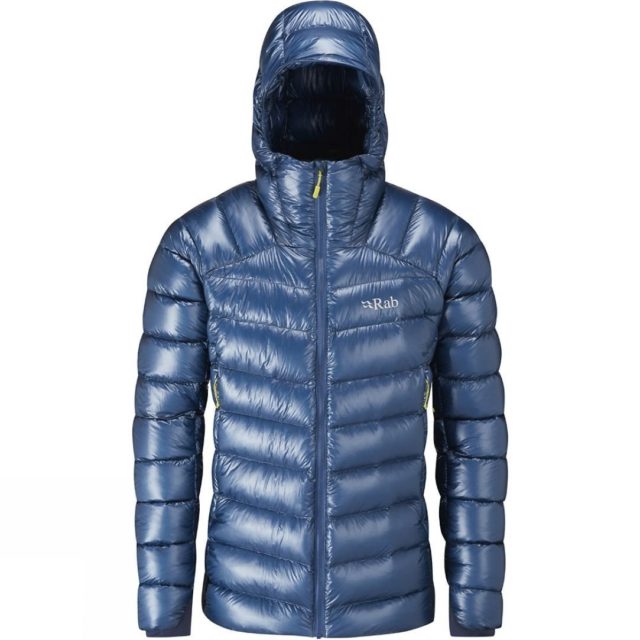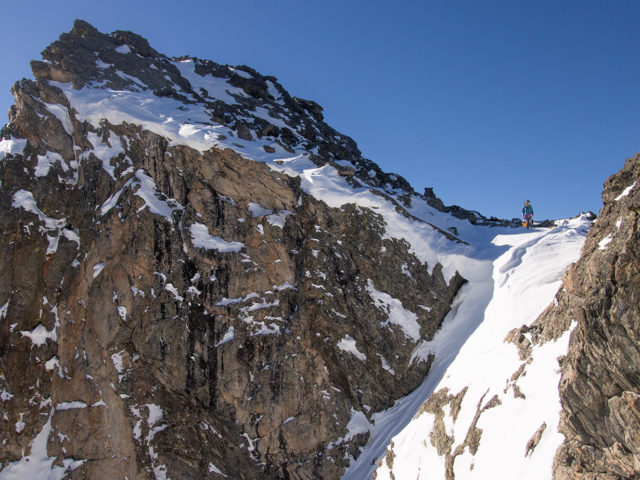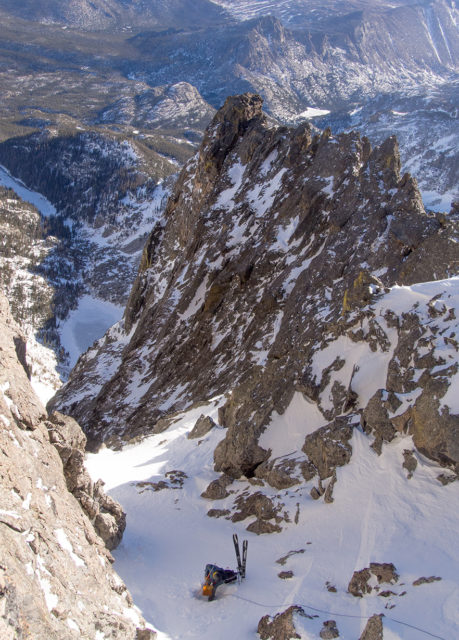
Rab Zero G Jacket
Reviewer: 5’10”, 140 lbs
Size Tested: Medium
Blister’s Measured Weight: 284 g (stuff sack: 6 g)
Materials:
- Fabric: Pertex Quantum GL 7D
- Insulation: 1000+FP R.D.S. Certified European Goose Down (stated, 130g/4.5oz size L)
Stated Features:
- Stitch through midi channel construction
- Down filled hood with flexible polymer peak
- YKK® VISLON® front zip with insulated zip baffle
- 2 YKK® CONCEAL® zip hand-warmer pockets
- Semi-elasticated hem
- Elasticated stretch woven cuffs
- Quantum® GL Stuff sack
- Fit: Slim
Pockets:
- 2 Hand warmer pockets
MSRP: $550
Test Locations: Rocky Mountain National Park & Telluride, CO; Hokkaido, Japan; Lake Tahoe, CA; Wasatch mountains, UT
Days Tested: 20
Intro
There are two striking qualities about the Rab Zero G Jacket — things you’ll probably notice before you even put it on. First, it is exceptionally beautiful. Second, it is shockingly expensive.
With the Zero G, Rab set out to make the ultimate fast and light insulation layer, and they seem to have spared no expense in doing just that. The Zero G is minimal, incredibly light, warm, well-made, and expensive.
But how do all of these qualities translate in the mountains? And the big question: is it actually worth $550?
Fit
The fit on this jacket works really well for me. So many down jackets suffer from generic, boxy fits to appeal to the masses. But the Zero G has a really nice slim / slightly longer cut that fits my frame very well.
There is enough room for me to layer a baselayer, mid layer and minimal shell underneath the Zero G, and not much else. I can throw the Zero G on over a shell during transitions, and that takes up just about all of the extra interior room of the Zero G. I love this slim fit because it eliminates drafts and any extra fabric that can get caught on packs, rocks, etc.

The Zero G is cut a bit longer than the Montbell Alpine Light Parka, and about the same as the Patagonia Micro Puff Hoody. It has a longer hem in back that just about gives full butt coverage, and the front is a few inches shorter than that. It’s a bit bulky to fit under a harness, but I don’t mind that as it is usually too warm to climb in the Zero G, and I instead use it more as a belay jacket when climbing.
The arms of the Zero G aren’t cut for actually climbing, but they are the perfect length for belaying, taking pics, or other more casual activities. Unlike the Micro Puff, the sleeves of the Zero G don’t have the extra 1-2” of length to cover my wrists while reaching overhead. For me, this is not a problem. I prefer this cut as extra sleeve fabric bunching up is very annoying, especially in a jacket with this much loft.
If you’re someone with a bigger frame, you might want to consider sizing up — especially if your current midlayers / shells are on the bulkier side.
Materials
There are two primary materials that make up the Zero G: the insulation and the shell fabric.
The Zero G’s insulation is a rarity in the down world — 1000+ fill-power R.D.S. Certified European Goose Down. There are only a few pieces on the market that use 1000 fill power down. This high fill-power down is a large contributor to the Zero G’s huge price tag, and also what allows the Zero G to weigh in at an astonishing 284 g for a Medium.
R.D.S. (Responsible Down Standard) helps to ensure ethical treatment of the geese and ducks that the down is sourced from. That means no live plucking or force feeding.
An aside on fill-power and warmth: down fill-power numbers are quite confusing and often marketed incorrectly. The fill-power of down does not equate to the overall warmth of a garment. An 800 fill-power jacket can easily (and often is) less warm than a 500 fill-power jacket. For example, a Canada Goose Langford Parka uses 625 fill-power down and is FAR warmer than the Mountain Hardwear Ghost Whisperer jacket, which uses 800 fill-power down. Fill power is a measure of how much volume one ounce of down will occupy, measured in cubic inches per ounce. Higher fill power means a better loft-to-weight ratio — which translates into a better warmth-to-weight ratio. However, the amount of down in the garment is more of a factor in ultimate warmth, but most companies do not provide that info. If you need great packability and the best possible warmth-to-weight ratio, then high fill-power down is worth a look, otherwise, save some money and go with lower fill-power or synthetics options.
Anyway, the other important material in the Zero G is its face fabric. The Zero G uses a super light 7-denier Pertex fabric that is quite shiny. I know that the shiny look certainly isn’t for everyone, but I’m personally quite fond of it. The fabric has a great hand feel that is light and sturdy without being crinkly. It resists wrinkling quite well and it gives the Zero G a look befitting of its price tag.
But it isn’t only the face fabric that makes the Zero G a beautiful piece — the finish, attention to detail, and construction all make for a very aesthetically pleasing jacket.
The Zero G has raglan sleeves rather than traditional set-in sleeves. This contributes to the excellent fit and comfort, but also frames the body and face much more naturally than most boxy puffies. The raglan sleeve + baffle combo has a completely different feel than, say, a baseball shirt where the raglan sleeve contributes to a generally undefined silhouette. With the baffles and highly structured feel of the Zero G, the raglan sleeves give the jacket an excellent shape, it is easy to put on, and feels like nothing on your body. Huge props, Rab.
Ok, enough geeking out on stuff that only I care about. On to more important things…
Features
The Zero G is about as minimal as it gets. There are two hand warmer pockets, a little piece of moldable plastic in the hood brim, a small velcro adjustment on the back of the hood, and simple stretch-woven cuffs.
The hand warmer pockets are unremarkable. They close with “invisible” YKK zips that occasionally get caught up on the face fabric (invisible zips look nice, but they pretty much all suffer this issue).

The Zero G’s cuffs are the best cuffs I’ve ever used on an insulation piece. The cuff fabric is soft and has the perfect amount of stretch. The design of the cuffs allows them to stretch enough to push them up over my forearms while still being tight enough around my wrists to seal out drafts. The cuffs are yet another thing that makes this jacket so impressive.
The stiff fabric in the hood brim is very functional. It is small and unobtrusive, yet holds its shape well without getting kinked while packing in to the stuff sack. It is one of my favorite brim materials I’ve seen.
Weight
The Zero G is just stupid light. The only jacket in roughly the same category that I’ve used that weighs less is the Patagonia Micro Puff Hoody (255 g, medium) — BUT the Micro Puff offers significantly less warmth than the Zero G.

The Zero G probably has the best warmth to weight ratio of any jacket we’ve tested at Blister. It easily beats out the Micro Puff as it offers way more warmth at a very similar weight. The only other jacket that might beat out the Zero G is the Montbell Plasma 1000 Down Jacket. The Plasma 1000 has no hood or pockets but shares a similar face fabric and 1000 fill-power down. The Plasma 1000 is not nearly as warm as the Zero G, but it also weighs over 100 g less.
Warmth
The Zero G is on the warmer side of puffy insulation. It isn’t quite warm enough to break into the belay parka category, but it definitely sits on the upper end of non-belay down insulation. It’s warmer than the Patagonia Down Sweater, Micro Puff Hoody, Nano Puff, North Face Thermoball Jacket, and similarly warm as the Montbell Alpine Light.
Some people have noted that the upper chest is slightly under insulated. When I look at the patterning and pay attention while wearing it, I can feel that the Zero G is a bit thinner in the upper chest. However, I’ve never had this translate into noticeable cold spots while using the jacket.
Weather Resistance
Similar to other puffy jackets, the Zero G blocks most wind, and light precip. But if the skies open up, you’ll definitely need a shell to keep the down dry (the Zero G does not use water-resistant down).
Breathability
Again, similar to other puffy jackets, the Zero G doesn’t offer much in the way of breathability. If you want breathable mid layers, look at fleece or active insulation.
Durability
The Zero G is not a burly jacket. It weighs almost nothing and uses an incredibly light face fabric. I haven’t had any durability issues with mine yet, but I’ve also been being quite careful with it.

With hard use, especially on coarse alpine rock, the Zero G won’t last long. With careful winter use as a ski mountaineering layer, I expect it to hold up okay. I’ve had it out for about 20 days so far without issue, but if you’re typically hard on your gear, this isn’t the jacket for you.
Just remember, lightweight gear is not burly. The better care you take to keep it away from sharp edges and rough rock, the longer it will last.
Who’s It For?
The Zero G is beautifully constructed and designed, and the fit is excellent for folks with slim, athletic frames. However, it’s $100-200 more expensive than other jackets in the category.
Weigh these factors as you will, but I would personally have a hard time justifying the cost of the Zero G. However, if you are a diehard minimalist who needs to shave off every gram from your kit, regardless of cost, then the Zero G should be at the very top of your list.
There are a lot of puffy jackets on the market and they all accomplish very similar things. If the Zero G’s price tag makes you squirm, there are other options that also perform great, and do so at a lower price point (granted, they won’t be as light).
Bottom Line
The Rab Zero G Jacket is a beautiful insulation piece with an incredible warmth-to-weight ratio and a slim, athletic fit. If you need the ultimate in ultralight insulation, then the Zero G is one of the best options available. Otherwise, the price tag makes this jacket a bit pricey for many applications.

yes, Rab zero G jacket s warm enought for about 30 f , 1000 fill goose down super high. again, it keeps you toasty with only a tshirt underneath.
i m returning mine. way too expensive for a fabtic that rather feels cheap , sinve it has 7 denier on it.
NOT WORTH IT ,at least, for me that almost$ 400 us i paid for it.
if you are a statue amd wont move , then again, yhis thing will keep you warm at about 30 F . durability ? no good. eapecially ig one s thinking about going to mountains and stuff.
It has been Two years now since this review was posted. How is the Zero G jacket holding up?